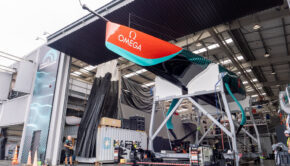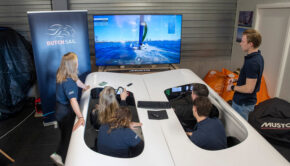Shaping the Foils that Re-Shaped the America’s Cup
Published on September 17th, 2013
Pete Melvin spoke with CupInfo in December of 2011, not long after the Morrelli & Melvin designer/partner had written the AC72 Class Rule and rumors were swirling that he would sign on to create one of the radical new boats for a certain America’s Cup challenger. Melvin looks back on his early expectations for the new boats, the cat-and-mouse of testing secret weapons in public, and making 72’ fully-foiling catamarans a reality:
When Pete Melvin co-wrote the design rule for the AC72 catamaran, he knew there were two distinct areas of development that could determine the winner of the 34th America’s Cup; the hard wing, an aspect of Oracle Team USA’s Cup-winning monster cat brought forward to this new era of Cup technology; and the foils. As it turns out, the 130’ wingsail, initially regarded as the radical innovation of this America’s Cup cycle, was overshadowed by the realization that these giant catamarans could not only foil downwind but upwind.
From the beginning of Melvin’s role on the AC72 design team of Emirates Team New Zealand, the watchword was “stable flight.” The team learned pretty early on that getting as much of the huge cat out of the water as possible was the key to speed. Consequently, the foils underwent a tremendous amount of development, from early models tested on the team’s SL33s to the “V” shaped version that led ETNZ to win the Louis Vuitton Cup, and may carry the America’s Cup back to Auckland.
“When we were working on the rule, we knew you wanted to get as much lift as possible when you were going fast downwind,” Melvin says. “For instance, in the 2010 America’s Cup, sailed on giant multihulls, the maximum amount of lift we thought we could get was about 50% of the weight of the boat. At that time, we were still relying on the hull to provide pitch control, so what’s come out of this is the boats all now have elevators (the horizontal foils on the rudders).
“At Team New Zealand, we developed a new type of foil that allows you to keep your height above the water more or less steady. No one had been able to do that before, at least not on a course-racing boat that was not going downwind. We developed that mostly on our SL33 test boats – they came with the stock constant curvature ‘C’ foils and with those kinds of foils, you can generate 50% boat weight lift before they get unstable.
“But we noticed that when we could get one boat up fully foiling for a few seconds it would really accelerate away from the other boat – and that got the wheels turning. How, with such a huge potential benefit, can we achieve stable flight downwind? So our design team came up with the ‘up-tip’ type of boards. We refined those on the 33s and our 72 is designed to do that and fortunately it worked right of the box.” – Read on








 We’ll keep your information safe.
We’ll keep your information safe.